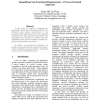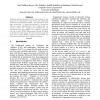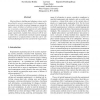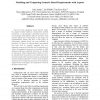RE
2004
Springer
14 years 6 months ago
2004
Springer
We present a method to identify stakeholders and their preferences about non-functional requirements (NFR) by using use case diagrams of existing systems. We focus on the changes ...
RE
2004
Springer
14 years 6 months ago
2004
Springer
Tools for managing systems requirements help keeping specifications consistent, up-to-date and accessible. Since the requirements for complex systems are themselves complex inform...
RE
2004
Springer
14 years 6 months ago
2004
Springer
In this work, we propose a framework for quantifying non-functional requirements (NFRs). This framework uses quality characteristics of the execution domain, application domain an...
RE
2004
Springer
14 years 6 months ago
2004
Springer
This paper addresses the issues related to improving the overall quality of the requirements tracing process for Independent Verification and Validation analysts. The contribution...
RE
2004
Springer
14 years 6 months ago
2004
Springer
This paper reports on our experience of eliciting and managing requirements on a large European-based multinational project, whose purpose is to create a system to support learnin...
RE
2004
Springer
14 years 6 months ago
2004
Springer
Assumptions are frequently made during requirements analysis of a system-to-be about the trustworthiness of its various components (including human components). These trust assump...
RE
2004
Springer
14 years 6 months ago
2004
Springer
Due to the generality and complexity of enterprise systems, they are challenging to implement and deploy successfully in organizations. Many of these problems are rooted in the wa...
RE
2004
Springer
14 years 6 months ago
2004
Springer
One of the benefits of goal-oriented requirements engineering is the possibility of conducting formal analysis in order to evaluate alternative solutions of goal models. Superfici...
RE
2004
Springer
14 years 6 months ago
2004
Springer
Most problems in building and refining a system can be traced back to errors in requirements. Poorly organized requirements, most often in natural language are among the major ca...
RE
2004
Springer
14 years 6 months ago
2004
Springer
There has been significant recent interest, within the Aspect-Oriented Software Development (AOSD) community, in representing crosscutting concerns at various stages of the softwa...




